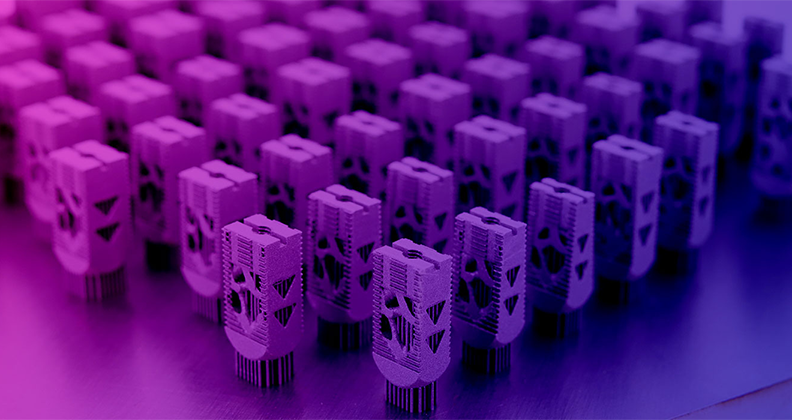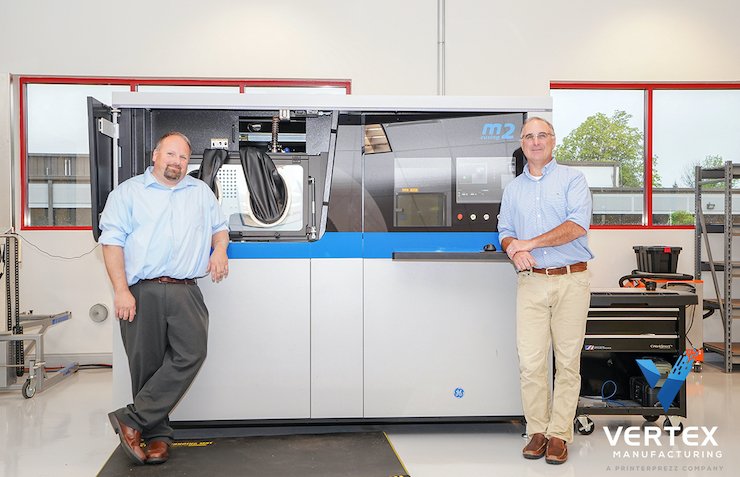
When PrinterPrezz and Vertex Manufacturing began working together in April 2021, they partnered to provide multiple services to support additive manufacturing for orthopedics. PrinterPrezz is a medical technology company that combines 3D printing with nanotechnologies, focusing heavily on the spine market. Vertex, meanwhile, specializes in metal additive manufacturing, polymer 3D printing and other manufacturing services for the medical, aerospace, defense, oil and gas, energy and consumer goods industries.
Just six months into the partnership, PrinterPrezz acquired Vertex Manufacturing.
“The PrinterPrezz executive team recognized that to achieve our goal of bringing low-cost, high-quality medical devices to the global population, we needed to expand our ecosystem and acquire the ability to post-process additively manufactured parts,” said Shri Shetty, CEO of PrinterPrezz. “When we began working with Vertex, we quickly recognized the synergy of combining the two entities.”
The two companies are complementary in nature with different capabilities in the supply chain, but they share a common objective of leveraging advanced technologies to create new designs while lowering costs, Shetty said.
On the heels of the merger, Vertex’s founder and additive manufacturing pioneer Greg Morris was named PrinterPrezz’s Chief Technology Officer. Vertex team members Steve Rengers and Tim Warden were also brought on board to complete the merged organization.
“Having worked with the Vertex team in the past, we were well aware of their additive manufacturing expertise and industry vision,” Shetty said. “Their stellar track record speaks for itself. They bring a wealth of knowledge on additive technologies that is vital in solving complex problems with optimized strategies that are cost-effective.”
Morris is known as an early adopter of advanced manufacturing, including metal additive manufacturing. He sold his companies Morris Technologies and Rapid Quality Manufacturing to GE in 2012. We caught up with Morris to get his perspective on his latest merger, the future of additive manufacturing in orthopedics and lessons that the medical device can adopt from other industries utilizing additive technology.
You recently became CTO of PrinterPrezz. What attracted you to the position and the collaboration with PrinterPrezz, and the ultimate merger of your companies?
Morris: Before we started Vertex, Shri had reached out to me and asked me if I would be interested in joining the PrinterPrezz advisory board, and I said, sure. I would have regular calls with Shri. Then when we started Vertex, Shri started thinking about some of the needs that PrinterPrezz was going to have regarding the post-processing of additive medical components, which they were making.
We started out with some conversations around Vertex being a vendor or supplier, and that’s what we ended up agreeing to informally. We put equipment on the floor and supplied the post-processing steps for PrinterPrezz. Throughout the first part of 2021, we started to enter into conversations around whether it would make sense to merge Vertex and PrinterPrezz, with the theory being, together, we’re probably a much stronger entity out in the marketplace than individually trying to plow forward ourselves.
Those conversations progressed and ultimately led to Vertex being acquired by PrinterPrezz. Vertex’s facility in Cincinnati does the post-processing of the medical implant components that PrinterPrezz is making. Cincinnati is going to be the production facility, and we are in the final stages of trying to secure a new space, which will be at least seven times the size of where we are today.
The PrinterPrezz team and the team from Vertex share very similar visions for where we believe our company will go and what the markets look like. I think things have gotten off to a fantastic start in the short three and a half months of being together now as one company. It’s been a great journey.
We hear your name and Morris Technologies mentioned a lot due to your pioneering work in additive manufacturing. To our knowledge, you’ve focused primarily on other industries, though, during your career. What enticed you about additive manufacturing in orthopedics and medical devices specifically?
Morris: It’s probably not as well known, but we actually had a very heavy presence in the medical arena back in the Morris Technologies days. Before our acquisition by GE in 2012, we were starting to do quite a bit of work with all the major orthopedic OEMs. GE divested that medical portion of Morris Technologies after the acquisition.
For clarity’s sake, we are not just focusing on medical. We are involved in the aerospace, energy, oil and gas and other markets, but medical clearly is a very big focal point by virtue of PrinterPrezz.
A multitude of things attracted us to a company that is solely focused on the medical business.
First off, I would say that Shri and PrinterPrezz have been very clear that their focus is medical, but they recognize the value in having other industries that Vertex works with. A lot of good cross pollination of ideas can happen. And on the medical side, I think the synergy that we saw with PrinterPrezz was a deep domain knowledge in how to apply their printing capabilities and go through all the regulatory aspects with FDA.
Ultimately, PrinterPrezz sees themselves playing in other markets outside of the traditional ones, and they have a little bit of a different type of approach to the traditional market. From our perspective, that was a growth opportunity. It was a company willing to invest more significantly and faster than we could have done alone. And all those things are very attractive to us.
We also bring, obviously, a lot of background in additive. So, from just a technology standpoint, it made a lot of sense. And then what capped it for me is that we have very similar company cultures and approaches to how we go out to the market. That, to me, is probably one of the most important things in any merger or acquisition or combination of entities. You want to be as closely aligned culturally as you can.
What lessons can those in orthopedics learn from other industries that have utilized additive manufacturing?
Morris: I think that the medical industry has been an early adopter, relatively speaking, with additive manufacturing as has the aerospace and automotive industries. Across all industries, there is still a lot of maturing to do relative to moving these technologies into the production arena, and that can be from a technology standpoint, a process standpoint, etc. However, when you’re dealing especially with these technologies that are creating metal parts or PEEK parts, these are mission-critical to the extent that they’re going into a very regulated industry.
Much like aerospace, medical is a highly regulated environment where you really can’t afford to have an oops, because that has dire consequences in some cases. You have to be very careful about who you’re working with. Anybody with enough dollars can go buy a metal additive system or a polymer system and produce parts, but that does not translate into those entities having a deep and thorough understanding of all the characteristics of how to produce high-quality components.
It’s really important to make sure that whoever’s operating the equipment or whoever has the equipment, whether it’s internal to the OEM, or whether it’s with external suppliers, that the folks who are operating the equipment and working the entire process have the right certification systems in place and well beyond that.

Steve Rengers and Greg Morris of Vertex Manufacturing, which was acquired by PrinterPrezz.
What additive manufacturing advancements do you expect that we’ll see in orthopedic implants in the coming years?
Morris: There’s huge upside and opportunity to leverage additive manufacturing. I think we’re touching the surface on where it can be applied. My personal belief is that as more engineers and designers and surgeons understand the value proposition from a design perspective, or even a cost perspective, we’re going to see many more examples of additive being used as the primary production methodology over traditional manufacturing methods.
The runway looks fantastic over the next five to 10 years. I think there’s going to be a real explosion of opportunity to leverage additive and the various modalities and different technologies that are out there to drive cost down, drive innovation up, and ultimately lead to better patient outcomes.
In your decades of working with companies to produce additively manufactured parts, what have you found is the most difficult part of the process for companies?
Morris: I think there are two big challenges.
One is, as an engineer and designer, do they know how best to design with a particular additive technology or modality in mind? There are those who have a surface understanding, and those who have a deep understanding of all the little nuances. Those with deep understanding are going to be most effective in designing components and parts and instruments and implants with additive in mind. It is a different thinking and mentality, generally speaking, than traditional manufacturing.
That leads to another challenge for additive, which is that there are a number of secondary processes one has to be aware of. It is not as simple as just growing a metal part. There’s prep work to figure out the orientation, file prep work, and then on the back end, there’s thermo processing. In the medical world, there are certain cleaning steps you go through, certain post-machining inspection, sterilization and packaging. You’ve got to think of all these things through no differently than you would with any other manufacturing process.
People tend to think additive is a shortcut when it is not a shortcut; it’s just another tool in the toolbox, but an enabling technology.
HT
Heather Tunstall is a BONEZONE Contributor.




